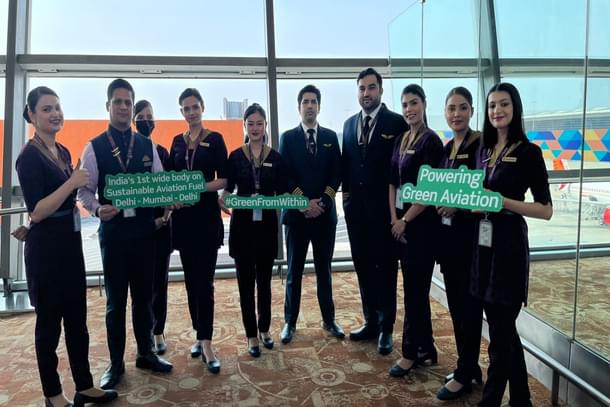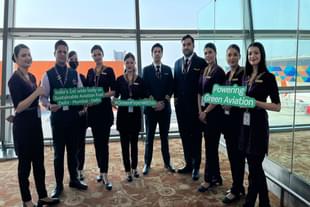Infrastructure
In A First For Indian Airlines, Vistara Operates A Commercial, Wide-Body Aircraft Using Sustainable Aviation Fuel
Amit Mishra
May 05, 2023, 02:02 PM | Updated 02:25 PM IST
Save & read from anywhere!
Bookmark stories for easy access on any device or the Swarajya app.


Full-service carrier Vistara, on 4 May created history by operating India's first domestic commercial flight on a wide-body aircraft using sustainable aviation fuel (SAF).
This historic feat was achieved on Vistara's brand new Boeing 787-9 Dreamliner, flying from Delhi to Mumbai, using a blend of 17 per cent SAF with 83 per cent conventional jet fuel.
The pioneering initiative helped Vistara reduce approximately 10,000 pounds of CO₂ emissions and is part of company’s ongoing efforts to minimize carbon footprint.
Earlier, last month, Vistara became the first Indian carrier to operate a wide-body aircraft on a long-haul international route using a blend of SAF when it operated the delivery flight of a Dreamliner between Charleston International Airport, South Carolina to IGI Airport, Delhi.
This ferry flight (without passengers, only operating crew) on Boeing 787-9 aircraft using a blend of 30 per cent SAF with 70 per cent conventional jet fuel helped Vistara reduce about 1.5 lakh pounds of CO₂ emissions over the fuel’s life cycle.
Vistara CEO Vinod Kannan said, “We have always been committed to driving sustainability and innovation in aviation, and are delighted to carry out yet another industry-first initiative of operating a commercial flight on a wide-body using SAF. We are thankful to our partners and the relevant authorities for their support.”
What is SAF
SAF is a clean substitute for fossil jet fuels. Rather than being refined from petroleum, SAF is produced from sustainable resources such as waste oils from a biological origin, agri-residues, municipal solid wastes or algae.
SAF can reduce Carbon dioxide emissions by as much as 65 per cent over the fuel’s life cycle with the potential to reach 100 per cent in future. It is recognised as offering the most immediate and greatest potential to decarbonise aviation over the next 20-30 years.
The International Civil Aviation Organization (ICAO) last year adopted a target to cut emissions to net zero by 2050, and SAF has long been seen as the industry’s fastest way to reduce emissions.
Mile markers
The path to airlines using SAF has been a long one. From the first tentative test flight in 2008, to the first commercial flight using SAF in 2011, this year will see the world’s first net zero transatlantic flight using 100 per cent SAF.
In 2023, one of Virgin Atlantic’s flagship Boeing 787s, powered by Rolls-Royce Trent 1000 engines, will take off from London Heathrow and make the journey to New York’s John F Kennedy Airport using solely sustainable aviation fuel.
As on date, Airbus and Boeing aircraft are capable of flying with up to a 50 per cent blend of SAF. Both the manufacturers aim to enable 100 per cent SAF capability by 2030.
Among Indian carriers, IndiGo on 18 Feb 2022 operated its A320 NEO flight from Toulouse, France to New Delhi with 10 per cent blend of sustainable aviation fuel under the IndiGo Green initiative.
Similarly, SpiceJet had conducted a demonstration flight with Bombardier Q400 aircraft in August 2018 using bio-fuel blended with Aviation fuel (in the ratio of 25:75) in one engine.
Vistara, along with other airline companies of the TATA group, has been working extensively towards reduction of carbon emissions through use of sustainable technologies.
Last year, they had signed an MoU with the Council of Scientific and Industrial Research - Indian Institute of Petroleum to collaborate on the research, development and deployment of sustainable aviation fuels.
Vistara is also working through the Carbon Offsetting and Reduction Scheme for International Aviation (CORSIA), to lower Carbon dioxide emissions for international flights and to curb the industry’s impact on climate change.
However, the main issue remains sustainable availability of SAF — in terms of regularly getting the required quantity of this fuel. India, like other countries, is trying to increase the same as aviation aims to become carbon neutral or net zero by 2050, with significant cuts having achieved by 2030.





